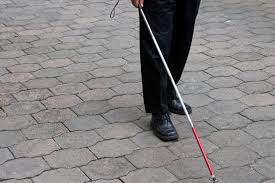Danielle Burden began working with Ensight as an Orientation and Mobility (O&M) Specialist in 2017. She provides O&M training for Ensight consumers and is also a Certified Teacher of the Visually Impaired and Orientation & Mobility Specialist for Greeley District School System in Weld County.
Q: Are white canes only for people who are completely blind?
A: White canes are used by people with a range of vision loss. White canes help to support a person’s safe independent and efficient travel.
Q: When is it time for someone to consider using a white cane?
A: A person should always consult with an orientation and mobility specialist prior to using a white cane. Considering using a white cane can look different for everyone. A person may notice a change in their vision, difficulty in navigating, and traveling in places or areas in which they were previously comfortable. Tripping, falling, bumping into objects or people, uncertain about drop-offs, becoming disoriented in once-familiar areas, or feel scared to travel to/in new places may be other indications of a need for an O&M evaluation.
Q: Is orientation and mobility training synonymous with white cane training? What does it entail?
A: The goal of orientation and mobility is to provide a person with the safest, most efficient, and independent travel possible. This looks different for each person depending on their need. Some people may need skills to travel within their home, protective techniques, sighted guide, skills to learn how to orient in their environment, support in training their guide dog on a certain route, or how to use their low vision aids such as; monocular or GPS app. White cane skills can be part of O&M but it is not the only skill set addressed in training.
Q: How do you begin training someone in orientation and mobility, and what skills do people learn in order to travel safely?
A: For me, I approach each situation by building a relationship with the person. It can take a lot of trust to move through space with someone you don’t know. I also ask lots of questions about the person’s vision, their current struggles in traveling, what personal goals and concerns they may have about O&M. I may ask them to show me certain areas of their living environment ie; mailbox, driveway, sidewalk around the block, stair access, structures on their property, elevator in the building, etc. Generally, O&M skills start indoors in a familiar area, then as the person is comfortable we move to outdoor or unfamiliar indoor areas. Street crossings, transportation options, etc skills are addressed as the person is comfortable.
Q: Are there some people that O&M training is not appropriate for?
A: Personally, I would say no, however, the level of safe, efficient, and independent travel depends on a variety of conditions and circumstances. For me, it is based on a person’s individual needs and abilities at the time. Some skills have a set of prerequisite skills that are needed before moving on to other skills. I believe people have a right to have as much independent movement as possible.
Q: What makes some people reluctant to use a white cane?
In my experience, some people are afraid of what the white cane represents to others. It may mean they will be treated differently, thought less of, look different, or draw attention to themselves. They may also struggle with what a white cane represents to themselves. That their vision is declining and coming to terms with this can be difficult. Some people may be intimidated by learning a new set of skills with this new object.
Q: How have you seen people’s perceptions of cane use change as a result of going through the training?
A: Over time I have seen kids and adults begin to accept, trust, and gain independence from using their cane. Some start to see it as a tool that helps them and the worry about what others think lessens because it gives them greater freedom. Their self-esteem and confidence increases as their experience in traveling independently increases.
Q: How are their lives affected overall by the training?
A: This would be a good question for those who have had the training. Some people I have worked with have gone on to obtain a guide dog, continue to access their community as they previously had, now walk to their mailbox independently, have more confidence in exploring new areas of travel, and have confidence in their ability to problem solve situations to maintain safety and orientation.
Q: How do you train people to use both the cane and a guide dog?
A: I support the person as they work with their guide dog. I do not interfere or train a guide dog. I have helped people with a guide dog locate specific turns on routes, entrances, and unfamiliar locations as they train their dog in these areas. Some people have used a cane to explore a surrounding area when training their guide dog on certain landmarks and to help orient themselves. I have also supported a couple of people to gain their cane skills, mobility, and orientation in order to obtain a guide dog.
Q: What else should people know about O and M training?
A: Ask lots of questions, no question is too silly to ask. Talk to others who use a cane or have had O&M training or who may be considering using a cane to support one another in this journey.
What is your title?
Ensight Team Member Daniel Burden is a TVI/COMS Teacher of the Visually Impaired/Orientation & Mobility Specialist
Learn more about O&M training at tbsvi.org.
